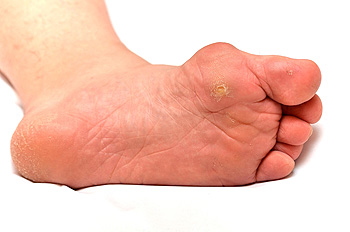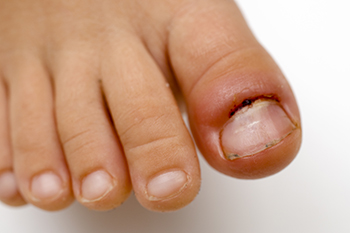Items filtered by date: July 2023
Heel Spurs Can Be Painful

A calcium build-up on the underside of the heel may indicate a heel spur has developed. It can happen by increasing speed and distance too quickly while running or by wearing shoes with inadequate support. Additionally, medical conditions such as rheumatoid arthritis may cause a heel spur to develop. Regardless of the cause, a heel spur can be painful, and walking can become difficult. A diagnosis is often performed, which consists of having an X-ray taken. This is successful in ruling out a fractured heel bone. The symptoms associated with a heel spur can include sharp pain under the foot, which may become worse after a prolonged time of rest, and the affected foot may feel warm when touched. Treatment can begin with elevating the foot and temporarily stopping the activity that may have caused the heel spur. Performing specific stretches may help to alleviate some of the discomfort, as well as to maintain a healthy weight. If you have heel pain, it is strongly suggested that you speak to a podiatrist as soon as possible who can effectively diagnose and treat heel spurs.
Heel spurs can be incredibly painful and sometimes may make you unable to participate in physical activities. To get medical care for your heel spurs, contact one of our podiatrists from Itasca Foot & Ankle. Our doctors will do everything possible to treat your condition.
Heels Spurs
Heel spurs are formed by calcium deposits on the back of the foot where the heel is. This can also be caused by small fragments of bone breaking off one section of the foot, attaching onto the back of the foot. Heel spurs can also be bone growth on the back of the foot and may grow in the direction of the arch of the foot.
Older individuals usually suffer from heel spurs and pain sometimes intensifies with age. One of the main condition's spurs are related to is plantar fasciitis.
Pain
The pain associated with spurs is often because of weight placed on the feet. When someone is walking, their entire weight is concentrated on the feet. Bone spurs then have the tendency to affect other bones and tissues around the foot. As the pain continues, the feet will become tender and sensitive over time.
Treatments
There are many ways to treat heel spurs. If one is suffering from heel spurs in conjunction with pain, there are several methods for healing. Medication, surgery, and herbal care are some options.
If you have any questions feel free to contact our offices located in Itasca and Hoffman Estates, IL . We offer the latest in diagnostic and treatment technology to meet your needs.
Wounds That Don't Heal Need to Be Checked
Corn-Free Feet

Corns are areas of hardened skin that usually appear on the top of the feet and around the toes. They form on pressure points or around bony areas and usually come from shoes that are too tight and cause pressure or friction on the feet. Corns can become irritated and painful. While it may seem counterintuitive, corns develop to protect the feet from further damage. Beyond ill-fitting shoes, corns can develop from gait abnormalities or structural issues with the feet. Things that can help relieve the pressure of this affliction are using corn pads, getting custom orthotics made, and wearing better-fitting shoes. Soaking the feet in warm water, rubbing corns gently with a pumice stone, and moisturizing the skin can also help. Patience is needed as it can take time for corns to shrink and go away. If you have corns that are larger or worsen, it is suggested that you see a podiatrist for further treatment.
If you have any concerns regarding your feet and ankles, contact one of our podiatrists of Itasca Foot & Ankle. Our doctors will treat your foot and ankle needs.
Corns: What Are They? and How Do You Get Rid of Them?
Corns can be described as areas of the skin that have thickened to the point of becoming painful or irritating. They are often layers and layers of the skin that have become dry and rough, and are normally smaller than calluses.
Ways to Prevent Corns
There are many ways to get rid of painful corns such as wearing:
- Well-fitting socks
- Comfortable shoes that are not tight around your foot
- Shoes that offer support
Treating Corns
Treatment of corns involves removing the dead skin that has built up in the specific area of the foot. Consult with Our doctors to determine the best treatment option for your case of corns.
If you have any questions please feel free to contact our offices located in Itasca and Hoffman Estates, IL . We offer the newest diagnostic and treatment technologies for all your foot and ankle needs.
Toe Infections

A toe infection can start small and end up big in terms of pain and serious consequences if not tended to. Such an infection can arise from an injury, an unrelated medical condition, a nail problem like an ingrown toenail, wearing shoes that are too tight, or bacteria. Symptoms beyond pain include pressure, swelling, redness, oozing, a bad smell, and being hot to the touch. One might see a visible break in the skin and have a fever as well. Being a diabetic can make dealing with toe infections particularly difficult. In severe cases, this type of infection can lead to a toe amputation. Prevention is key to treating toe infections. Toes, in between toes, and toenails should be checked frequently for any abnormalities. Feet should be kept clean, and socks changed often. Toenails should be cut straight across and not too short. Going barefoot should be avoided. Shoes should be roomy enough that toes can wiggle freely. If you develop a toe infection, it is strongly suggested that you see a podiatrist as soon as possible for treatment.
Wound care is an important part in dealing with diabetes. If you have diabetes and a foot wound or would like more information about wound care for diabetics, consult with one of our podiatrists from Itasca Foot & Ankle. Our doctors will assess your condition and provide you with quality foot and ankle treatment.
What Is Wound Care?
Wound care is the practice of taking proper care of a wound. This can range from the smallest to the largest of wounds. While everyone can benefit from proper wound care, it is much more important for diabetics. Diabetics often suffer from poor blood circulation which causes wounds to heal much slower than they would in a non-diabetic.
What Is the Importance of Wound Care?
While it may not seem apparent with small ulcers on the foot, for diabetics, any size ulcer can become infected. Diabetics often also suffer from neuropathy, or nerve loss. This means they might not even feel when they have an ulcer on their foot. If the wound becomes severely infected, amputation may be necessary. Therefore, it is of the upmost importance to properly care for any and all foot wounds.
How to Care for Wounds
The best way to care for foot wounds is to prevent them. For diabetics, this means daily inspections of the feet for any signs of abnormalities or ulcers. It is also recommended to see a podiatrist several times a year for a foot inspection. If you do have an ulcer, run the wound under water to clear dirt from the wound; then apply antibiotic ointment to the wound and cover with a bandage. Bandages should be changed daily and keeping pressure off the wound is smart. It is advised to see a podiatrist, who can keep an eye on it.
If you have any questions, please feel free to contact our offices located in Itasca and Hoffman Estates, IL . We offer the newest diagnostic and treatment technologies for all your foot care needs.
Heel Bruises

When a heel becomes injured, it is common for it to look bruised and swollen. This can happen from overuse or from participating in high-impact sports, and it can be painful. Resting the affected foot can often help, in addition to making sure to wear shoes that fit well. It is important to ensure that shoes have enough room in the heel area to avoid excessive pressure, and it is beneficial to wear shoes that are appropriate for the activity being done. Using shoe inserts can provide extra support to cushion the sore heel, and wearing shoes with a low heel can shift the foot forward onto the ball of the foot. This is often effective in taking the pressure off the heel. If it is not possible to stay off the feet for the time required for healing, using crutches or a knee scooter can help with mobility without putting excess weight on the foot. Because there are so many reasons a heel can become bruised, it is important to be aware if the bruise worsens. If you have heel pain, it is suggested that you seek the counsel of a podiatrist who can examine your foot and administer proper treatment.
Many people suffer from bouts of heel pain. For more information, contact one of our podiatrists of Itasca Foot & Ankle. Our doctors can provide the care you need to keep you pain-free and on your feet.
Causes of Heel Pain
Heel pain is often associated with plantar fasciitis. The plantar fascia is a band of tissues that extends along the bottom of the foot. A rip or tear in this ligament can cause inflammation of the tissue.
Achilles tendonitis is another cause of heel pain. Inflammation of the Achilles tendon will cause pain from fractures and muscle tearing. Lack of flexibility is also another symptom.
Heel spurs are another cause of pain. When the tissues of the plantar fascia undergo a great deal of stress, it can lead to ligament separation from the heel bone, causing heel spurs.
Why Might Heel Pain Occur?
- Wearing ill-fitting shoes
- Wearing non-supportive shoes
- Weight change
- Excessive running
Treatments
Heel pain should be treated as soon as possible for immediate results. Keeping your feet in a stress-free environment will help. If you suffer from Achilles tendonitis or plantar fasciitis, applying ice will reduce the swelling. Stretching before an exercise like running will help the muscles. Using all these tips will help make heel pain a condition of the past.
If you have any questions please contact our offices located in Itasca and Hoffman Estates, IL . We offer the newest diagnostic and treatment technologies for all your foot and ankle needs.
